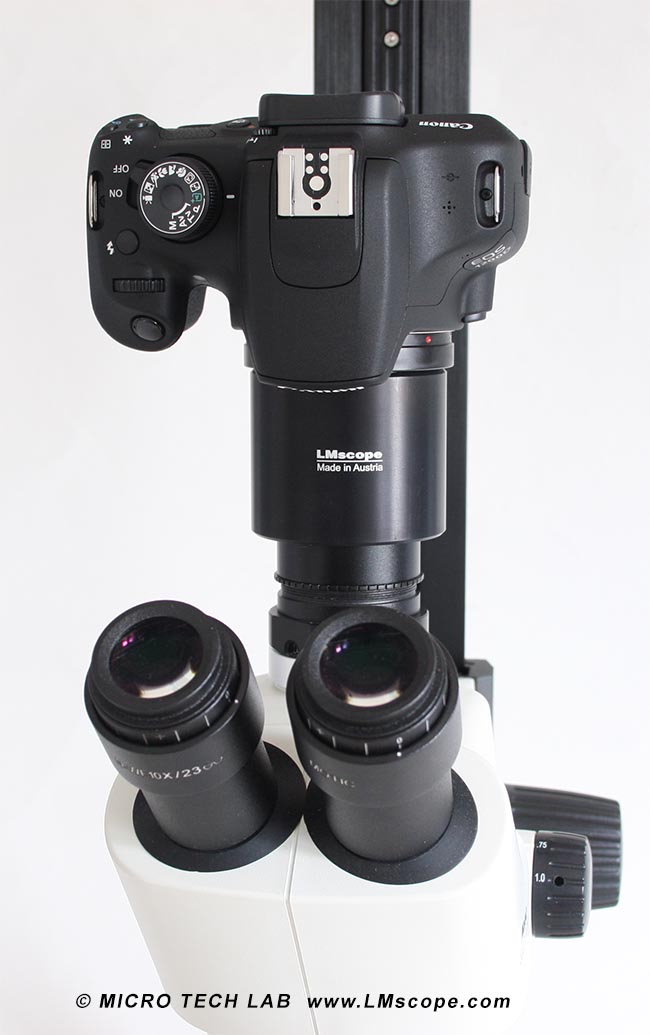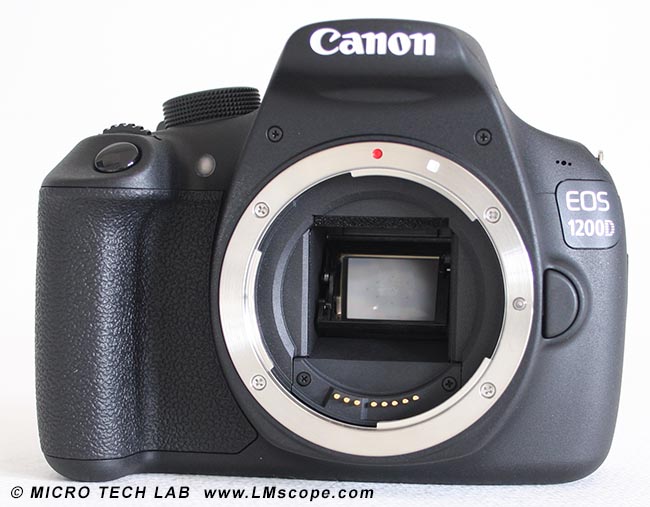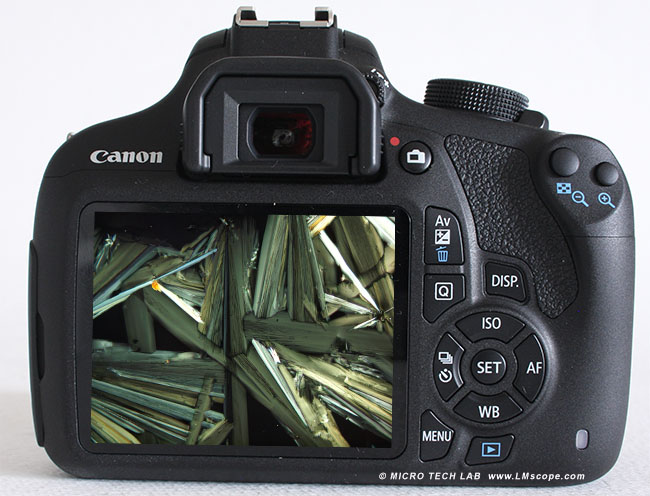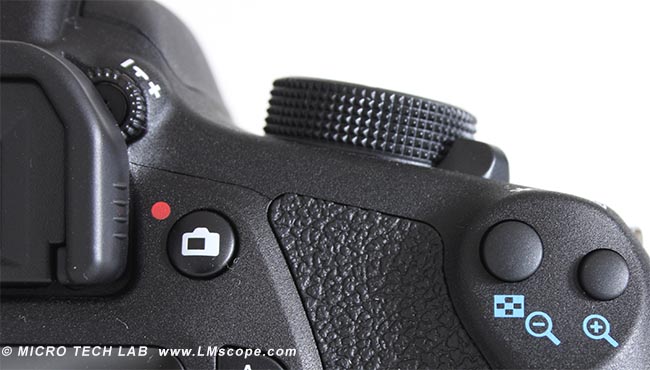

The Canon EOS 1200D: a simple camera suitable for microscope use that offers a good price/performance ratio
For several years, Canon has been offering a range of DSLR cameras that provide substantial value for their cost. We wondered whether these cameras were also suitable for the specialised field of photomicrography. Having already tested the Canon EOS 1000D, we now felt that the time had come to subject the Canon EOS 1200D to extensive investigation and provide a detailed description of our findings.

The Canon EOS 1200D has a simple polycarbonate body. Since it weighs in at just 445 grams (without lens), it is very well suited for use with more delicate microscope stands. The camera is definitely on the smaller size and comfortable to hold. Its body is more than adequate for use in microscopy. As a rule, the camera is attached to the microscope with an LM digital microscope adapter, and then remains in place. Once mounted, the camera should be touched as little as possible to avoid creating vibration blurs. For this reason, the camera body is not subjected to much use.
When used in microscopy, cameras are typically controlled via a PC or Mac, and as with every camera in the Canon EOS line, the EOS 1200D can be controlled remotely using the Canon EOS Utility software (included free of charge with Canon cameras). The EOS Utility software offers numerous advantages: improvement of the image quality, ability to save photos and videos directly to the PC/Mac, increased convenience of camera operation, etc.
Unlike the more expensive EOS models, Canon’s EOS 1200D does not have a display that rotates or tilts, which is a disadvantage when working without the Canon EOS Utility software. To check the focus setting, for example, it is necessary to repeatedly get up and look at the display from above. The display itself, just 3" in size, offers an average resolution (approximately 460,000 pixels) but is not touch sensitive.


The camera has an 18.6 megapixel APS-C sensor, which represents a considerable performance increase over the Canon EOS 1000D (which has only 10 megapixels). The automatic light sensitivity ranges from ISO 100 to 6,400 and can be increased manually to ISO 12,800. The colour depth is 42 bits. At 11.3 f-stops, the camera’s dynamic range is adequate, and the signal to noise ratio is low. Videos can be recorded in full HD format at a 30 fps frame rate.

When using a camera for microscopy applications, an important factor to consider is the magnification function in Live View mode. The Canon EOS 1200D offers that capability. The + and - buttons that control the zoom are located at the rear of the camera.
If necessary, a large HD monitor can be connected to the camera via an HDMI cable. This connectivity makes it possible to share the Live View image with larger groups of people, such as during presentations, lectures or in working groups. It is very easy to turn off the camera information display by pressing the “Disp” button.
Compared to other models, Canon has economised on some features in the EOS 1200D. However, many of these functions – for example the slower autofocus – are irrelevant for microscopy applications since the focus is adjusted via the microscope and not the camera.
The Canon EOS 1200D does not have GPS or WiFi capabilities, but those functions are usually not required for photomicrography anyway. Since the camera is permanently attached to the microscope in most cases (to the eyepiece, photo tube, C-mount connection, etc.) and then remains stationary in the studio or lab, the GPS function is superfluous. Similarly, the absence of wireless connectivity is no great detriment since the currently available apps are not nearly as effective as the USB connections with Canon’s EOS Utility software.
Conclusion:
The Canon EOS 1200D is a real money saver. With our tried and tested LM digital adapters, it can be easily attached to both photo tubes and eyepiece tubes. While the camera has everything most microscopy users could wish for, a display that rotates and tilts would have been advantageous – but Canon’s EOS Utility software more than fills that void.
28.10.2015
New LM Digital Adapter for: Canon EOS R3 / Canon EOS R6 Mark II / Canon EOS R8 / Canon EOS R5 / Canon EOS R6 / Canon EOS R / Canon EOS Ra (Astro) / Canon EOS RP / Canon EOS R7 / Canon EOS R10 / Canon EOS 1D X Mark III / Canon EOS 1D X Mark II / Canon EOS R100 / Canon EOS 1D X / Canon EOS 90D / Canon EOS 5D Mark IV / Canon EOS 6D Mark II / Canon EOS M6 Mark II / Canon EOS 250D / Canon EOS 850D / Rebel T8i / Canon EOS 6D / Canon EOS M200 / Canon EOS 5DS R ( without low-pass filter) / Canon EOS 80D / Canon EOS M50 Mark II / Canon EOS 5DS / Canon EOS M50 / Canon EOS 70D / Canon EOS 200D / Canon EOS 800D / Rebel T7i / Canon EOS 77D /